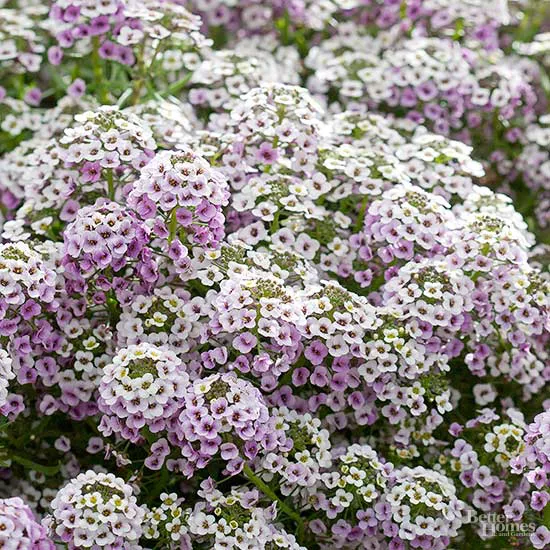These Winter Flowers Keep Your Garden Colorful Even When It's Cold

For many, winter marks the end of the growing season—a reprieve from dirty knees and garden spades. For others, winter means an opportunity to coax more color out of the ground. Gardeners in the South and Southern California can choose from a wealth of plants—annuals and perennials—that prefer cooler temperatures and promise beautiful winter flowers. Discover which plants will thrive in these regions during the winter to bring "off-season" blossoms to your flower beds.
Winter-Flowering Annuals
It's important to understand that annuals are just what their name implies: Plants that grow, set seed, and die within a year. Although some plants grown in northern gardens are treated as annuals, many are truly tender perennials that simply can't survive the winter cold. These annuals won't last forever, but they will bring welcome color to your winter landscape.
Sweet Alyssum
With 12-inch mounds of tiny, fragrant flowers in pink, white, or lavender, sweet alyssum (Lobularia maritima) is a favorite cool-growing annual. Use it to edge beds and paths, or tuck it into small, dark spaces. Grow it in full sun to part shade in well-drained soil. Although it tolerates some dry conditions, keep it watered for best performance. Expect alyssum to go dormant during hot weather. This plant grows best in Zones 9-11.
Calendula
The cheery yellow, cream, or orange blossoms of calendula (Calendula officinalis) light up a garden. If this annual is grown without chemicals, the peppery petals may be used as an edible garnish or chopped into cream cheese or dips. Grow calendula in full sun in Zones 2-11.
Honeywort
This may be the most unexpected of the winter annuals. Native to the Mediterranean, honeywort (Cerinthe major purpurascens) is an underused and unusual plant, with its silvery blue-green leaves and blue-purple flowers. It self-sows but dies out during hot weather. For best results, plant honeywort in full sun or light shade in Zones 9-10. Expect it to reach 2 to 3 feet tall and wide.
Sweet Pea
Grow annual sweet pea (Lathyrus odoratus) on trellises or obelisks where the tendrils of this vine, native to Italy, can climb up to 6 feet. Enjoy the clusters of fragrant, ruffled blossoms as cut flowers. Start sweet pea from seed by soaking them in water for 48 hours, then plant in full sun. Sweet pea grows best in Zones 6-9.
Winter-Flowering Perennials
Although many perennials prefer stronger light and warmer temperatures, these tough plants can withstand the cold for a dose of winter color.
Pansies and Violets
Pansies (Viola x wittrockiana) and violets ((Viola) species) are the reliable standbys for cool-weather blossoms. Their engaging "faces," or top petals, come in bold or pastel colors. Plant pansies 4 to 6 inches apart in rich, well-drained moist soil in sun or light shade. Water and fertilize them regularly. Remove spent flowers to promote repeat blooming. Violets thrive in full sun to partial shade and like well-drained soil.
Although they're both perennials, pansies and violets tend to be short-lived since they can't tolerate heat. Some pansy varieties are more heat-tolerant than others; violets withstand heat better and may reseed. Pansies will bloom all winter in warmer climates, and violets are known for being cold-tolerant. Both grow hardy in Zones 3-9.
Pinks
Pinks (Dianthus species and hybrids) are named not for their color—although many are pink—but for their serrated leaves, which look like someone cut them with pinking shears. The blooms often smell like an aromatic spice, such as nutmeg, ginger, or cinnamon. Many types of these short-lived perennials, including China pinks (Dianthus chinensis), grow in 6- to 12-inch mounds of grasslike blue-green foliage. Sweet William (D. barbatus) reaches up to 2 feet. Cheddar pinks (Dianthus gratianopolitanus) and maiden pinks (Dianthus deltoides) are also part of the family. Grow them in full to part sun. Zone hardiness varies by species.
Winter Jasmine
You'll love the early burst of color from winter jasmine (Jasminum nudiflorum), a fast-growing evergreen shrub that does best in full sun or light shade. This cold-weather perennial offers an abundance of creamy-yellow flowers. It can reach 10 feet tall and wide and is hardy in Zones 6-9.
Winter Honeysuckle
Drawing you in with one of the season's best scents is winter honeysuckle (Lonicera fragrantissima). This vine flaunts clusters of creamy-white flowers in late winter and early spring. It can grow 10 feet tall and wide and is hardy in Zones 5-8.